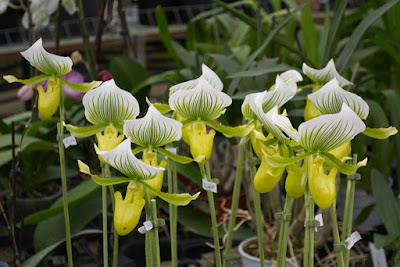Paphiopedilum Maudiae is a hybrid between Paphiopedilum callosum (native to Thailand, Cambodia, Vietnam and Laos) and Paphiopedilum lawrenceanum (native to Borneo). This orchid is a beautiful, old hybrid that stood the test of time for more than 100 years, where others have passed and gone out of fashion, this cross is still one of the most desired orchids ever.
Paphiopedilum Maudiae is a hybrid between Paphiopedilum callosum (native to Thailand, Cambodia, Vietnam and Laos) and Paphiopedilum lawrenceanum (native to Borneo). This orchid is a beautiful, old hybrid that stood the test of time for more than 100 years, where others have passed and gone out of fashion, this cross is still one of the most desired orchids ever.
IDENTIFY PAPHIOPEDILUM MAUDIAE ORCHID PLANT
Paphiopedilum Maudiae has attractive mottled green foliage, with rounded-oval leaves. The peduncles reach up to 30 cm in length. One peduncle has one flower. The flowers are green with white, measuring 10-12 cm in diameter. The lateral sepals are narrow, covered with thin hairs and small protuberances (in the manner of warts) like a fuzz. Upper sepals is wide, white with green veins. The lip is also green with dark veins.
The flowers may persist on the plants for as long as two months. Because of its easy growing requirements, which can be provided in most homes, P. Maudiae is a popular houseplant.
PAPHIOPEDILUM MAUDIAE ORCHID PLANT CARE AND CULTURE
Cultural information should only be used as a guide, and should be to be adapted to suit you. Your physical location; where you grow your plants, how much time you have to devote to their care, and many other factors, will need to be taken into account. Only then can you decide on the cultural methods that best suit you and your plants.
Light:
Paphiopedilum Maudiae is grown both in bright diffused light and in partial shade. The ideal location is considered to be the windows of the east orientation, however, if there are none in the apartment, then you can use the western or very bright northern windows. This orchid hybrid equally does not like, as too dark place (here the plant simply will not bloom), and too much light (orchid leaves can burn). If Western windows were chosen as the plant's location, then from May to early September, the orchid should be protected from the effects of too bright evening sun - put behind a curtain (for example, on a table near a window) or in the shade of other plants.
Temperature:
This type of orchid belongs to the warm temperature regime, and throughout the year it is recommended to keep the orchids under the following conditions: Day temperature up to 30 ° C. Night temperature not below 15 ° C. For the successful cultivation at home, it is necessary that the night temperature always be 4 ° C lower than the daily one.
Humidity:
Paphiopedilum Maudiae is not demanding of high humidity, and its index can vary from 40 to 70%. Too dry air adversely affects the development of the plant: its leaves become pale, and their tips begin to dry out. To increase the humidity of the air, you can use a humidifier, water saucers or wet clay. For this, a large pallet is taken, inside of which expanded clay is poured, a grate protecting the wetting of the roots is placed on top and pots with orchids are set up. The higher temperature, the higher the humidity should be, and the higher the humidity, the more often and longer it is necessary to ventilate the room where orchids are contained, otherwise there is a high probability of rotting and leaves of various kinds of fungal diseases.
Substrate, growing media and repotting:
In view of the fact that Paphiopedilum Maudiae is a terrestrial orchid, it is mainly grown only in pots. As a substrate, it is recommended to use a mixture of bark of conifers with coconut chips and sphagnum moss.
From frequent irrigation and fertilization, the substrate quickly decomposes and loses its main property, useful for orchids, is breathability, therefore, it is recommended to replace this hybrid annually or every two years. The best time for this is the period immediately after flowering.
Watering:
Watering this hybrid is directly dependent on the total temperature of the content, the higher it is, the more often it needs to be watered. Excess water during irrigation should flow freely from the pot, since stagnation of water both inside the pot and in its pan can very quickly lead to rotting of the roots and the lower part of the plant. The substrate between waterings should dry well. However, the long-term presence of an orchid in a completely dried substrate is not recommended.
Fertilizer:
Throughout the year, this hybrid is fertilized once every 3-4 weeks in the usual concentration of fertilizer indicated on the package. If the tips of the leaves begin to turn black and dry, the dosage of fertilizer must be reduced. With a strong blackening, the best thing is to transplant the plant immediately to a new substrate and continue to fertilize it less often and in a lower concentration.
Rest period:
Paphiopedilum Maudiae does not need a well-defined rest period to stimulate flowering. They may bloom at any time of the year. After flowering, the peduncle is removed, if necessary, the orchid is transplanted and kept relatively dry for some time. This is necessary to acclimatize the plant and to prevent wound rotting on the roots resulting from the transplant.















COMMENTS